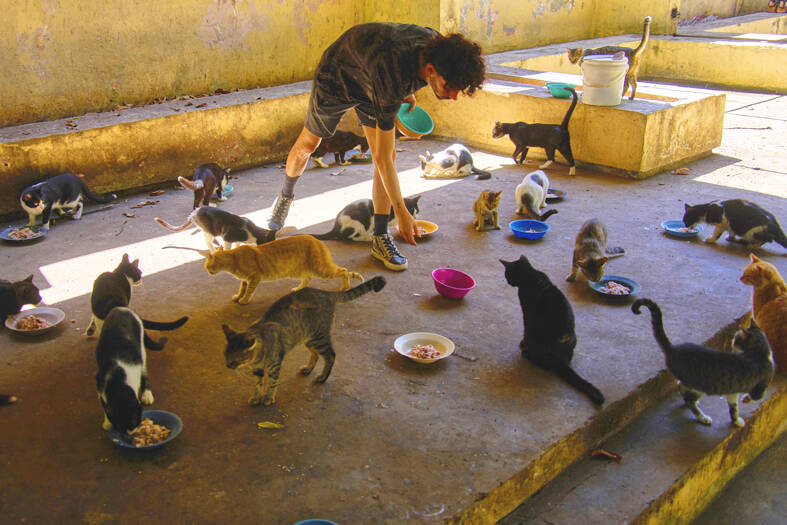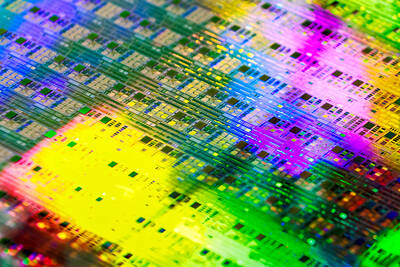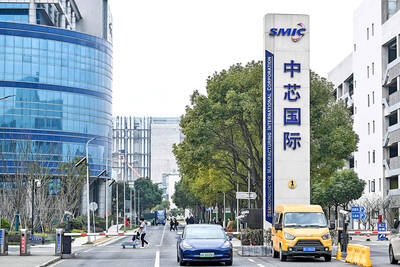Every afternoon, 81-year-old Nelida Perez begins her familiar walk down the cobblestone streets of Old Havana, a procession of hungry cats trailing close behind her.
For years, Perez has taken it upon herself to feed some of the street cats that roam this part of town, which is also one of the most popular tourist spots in the Cuban capital.
She once relied on her own food or restaurant donations, but as the island’s economic situation worsened and tourism declined, it has become increasingly difficult to provide for them.

Photo: AP
“I have never in my life asked anyone for a plate of food to feed my cats,” Perez said. “Now I see myself in difficulties because there is no tourism and there is an economic crisis.”
Since 2020, Cuba has faced a worsening economic crisis, driven by COVID-19 shutdowns, stricter US sanctions and an internal monetary reform that triggered inflation.
Although the government provides vaccines, sterilization and some free clinics, it does not have the means to provide shelter and food for street cats and dogs. While official data is unavailable, activists say that many pet lovers have turned their homes — even small apartments — into shelters, but they are struggling to keep up with the demand and provide adequate care.

Photo: AP
“The streets will kill them,” said Barbara Iglesias, a 51-year-old pharmacist who adopted five dogs and has rescued and found homes for a dozen others. Iglesias said that the hardest part is getting food.
A 20kg bag of dog food, which lasts one dog for about 45 days, costs about US$80 — a sum that is out of reach for most. This forces people to feed animals with pig organ meat (offal), chicken parts or minced meat, which are also not easy to obtain.
On top of that, annual vaccines cost about US$20, and a vet visit is another US$10, all while the average monthly salary on the island is only about US$12.
Experts say that the abandonment of animals in Cuba is a result of several factors, including rising food and medicine prices, the migration of hundreds of thousands of Cubans in the past five years, and a high mortality rate among older adults.
“People are more focused on their problems, which are numerous: Cubans don’t have water, they don’t have electricity, and getting food is becoming increasingly difficult,” said Annelie Gonzalez, one of the leaders of the Aldameros Project, a cat colony located in a park in Havana’s historic center.
“Having an animal in your care involves feeding and caring,” said Gonzalez, 36, who works as a restaurant manager and spends much of her income on the cats.
She and a small group of volunteers began feeding 15 cats in Aldameros Park at the beginning of the COVID-19 pandemic. Today, they care for more than 150. Over the years, through their own efforts and some donations, they were able to install water pumps, pens for special cases and cages for the kittens.
Gonzalez points to a number that she said reveals the shocking scale of the problem: At the start of the decade, about three abandoned cats appeared in the park each week. This year, that figure has soared to 15 per day.
Back in Old Havana, Perez recounts with sadness how she has seen people mistreat, beat and even kill stray cats.
“As long as I’m alive and healthy, and people help me,” she said, “I’ll always find them something to eat.”

NO BREAKTHROUGH? More substantial ‘deliverables,’ such as tariff reductions, would likely be saved for a meeting between Trump and Xi later this year, a trade expert said China launched two probes targeting the US semiconductor sector on Saturday ahead of talks between the two nations in Spain this week on trade, national security and the ownership of social media platform TikTok. China’s Ministry of Commerce announced an anti-dumping investigation into certain analog integrated circuits (ICs) imported from the US. The investigation is to target some commodity interface ICs and gate driver ICs, which are commonly made by US companies such as Texas Instruments Inc and ON Semiconductor Corp. The ministry also announced an anti-discrimination probe into US measures against China’s chip sector. US measures such as export curbs and tariffs

The US on Friday penalized two Chinese firms that acquired US chipmaking equipment for China’s top chipmaker, Semiconductor Manufacturing International Corp (SMIC, 中芯國際), including them among 32 entities that were added to the US Department of Commerce’s restricted trade list, a US government posting showed. Twenty-three of the 32 are in China. GMC Semiconductor Technology (Wuxi) Co (吉姆西半導體科技) and Jicun Semiconductor Technology (Shanghai) Co (吉存半導體科技) were placed on the list, formally known as the Entity List, for acquiring equipment for SMIC Northern Integrated Circuit Manufacturing (Beijing) Corp (中芯北方積體電路) and Semiconductor Manufacturing International (Beijing) Corp (中芯北京), the US Federal Register posting said. The

India’s ban of online money-based games could drive addicts to unregulated apps and offshore platforms that pose new financial and social risks, fantasy-sports gaming experts say. Indian Prime Minister Narendra Modi’s government banned real-money online games late last month, citing financial losses and addiction, leading to a shutdown of many apps offering paid fantasy cricket, rummy and poker games. “Many will move to offshore platforms, because of the addictive nature — they will find alternate means to get that dopamine hit,” said Viren Hemrajani, a Mumbai-based fantasy cricket analyst. “It [also] leads to fraud and scams, because everything is now

MORTGAGE WORRIES: About 34% of respondents to a survey said they would approach multiple lenders to pay for a home, while 29.2% said they would ask family for help New housing projects in Taiwan’s six special municipalities, as well as Hsinchu city and county, are projected to total NT$710.65 billion (US$23.61 billion) in the upcoming fall sales season, a record 30 percent decrease from a year earlier, as tighter mortgage rules prompt developers to pull back, property listing platform 591.com (591新建案) said yesterday. The number of projects has also fallen to 312, a more than 20 percent decrease year-on-year, underscoring weakening sentiment and momentum amid lingering policy and financing headwinds. New Taipei City and Taoyuan bucked the downturn in project value, while Taipei, Hsinchu city and county, Taichung, Tainan and Kaohsiung